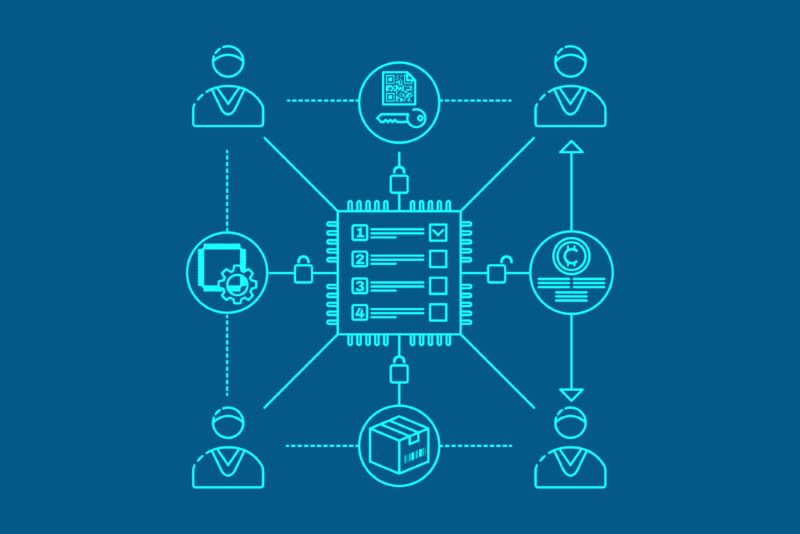What is Blockchain Architecture? It’s the blueprint of a new era’s web. It’s layers of ingenuity and security, locked into a chain of digital blocks. Imagine a towering fortress, but instead of stones and mortar, it’s made of data and trust. You’ve heard the buzz, seen the hype, but what’s beneath the surface? Dive in as we peel back the shell of this digital marvel, starting from the very core, to the cryptic workings of its layered realms. We’re on a quest to understand not just what it is, but how each component plays a critical role in creating an unshakeable digital fortress. Join me, your blockchain insider, as we dissect, layer by layer, the intricate world of distributed ledger technology and the astonishing mechanisms that keep it running like clockwork. Welcome to the trust revolution!
Understanding the Fundamentals of Blockchain Architecture
Defining the Core Elements of Blockchain
Think of blockchain as a strong chain of digital blocks. Each block holds a bunch of data. This chain is special because it is the same across a huge network. No one person calls the shots. Everyone in the network agrees on what blocks should join the chain. How? They use rules called consensus mechanisms.
Consensus mechanisms are the heart of blockchain. They make sure all copies of the chain are the same. Proof of work and proof of stake are two main types. Proof of work is like a race where computers solve puzzles to add a block. Proof of stake, on the other hand, lets holders of more currency pick the next block.
In blockchain, every piece of data gets a unique code called a hash. If the data changes, so does the hash. This makes blockchain secure. Smart contracts use this idea to auto-manage deals and agreements. With no need for middlemen, they slice fees and save time.
Exploring the Layered Structure of DLT Systems
Next, there’s the layered structure of blockchain, or distributed ledger technology (DLT). The layers keep everything in order. You’ve got a layer for recording stuff, a layer that makes sure things run smooth, and a top layer where actual users play.
Blockchain networks have smart contracts and apps that do all sorts of cool stuff. These layers manage the flow of currency, data, and make sure the rules stick. Some blockchains are open to all, while others are private, invite-only clubs.
Nodes are the watchers of the blockchain. They hold copies of all the blocks and keep the network safe and honest. It’s like a peer-to-peer network, where everyone shares and checks the blocks. This makes the chain tough to trick. Thanks to this structure, blockchain stands strong against hacks and frauds.
Blockchain isn’t just one size fits all. It can grow or shrink, making room for more data. Governance is needed to make sure everyone plays fair. With every change, the network votes. This makes it a trustless system; you don’t have to trust people, just the code.
To sum up, the blockchain’s architecture, with its unique layers and components, is a digital fortress. It stores data across a distributed database. It’s clear as glass and built for security. It’s not just a buzzword; it’s a revolution in keeping digital dealings honest, fair, and open.
Peeling Back the Layers: Dissecting Blockchain Components
Analyzing Network Layers and Node Functions
Blockchain is like a high-tech building made of different floors. Each floor has a special role. The first floor is where we find the network layer. It’s the foundation. Within this layer, computers called nodes talk to each other. Nodes are the keepers of blockchain’s information.
A node’s job is to keep a copy of all the data. This data is shared across many computers, creating a peer-to-peer network. Every node has a full history of transactions. When a new transaction happens, all nodes get an update. This makes sure that everyone has the same information.
Nodes also check new transactions. They make sure each transaction follows the blockchain’s rules. These rules are part of something called consensus mechanisms. They help all the nodes agree on what’s true and what’s not.
Some rules are like a race, which we call proof of work. Others are like a lottery, known as proof of stake. These rules are important. They keep the blockchain secure and fair for everyone.
The Role of Cryptographic Hashing and Data Integrity
Next, let’s talk about how we keep this data safe. Cryptographic hashing is key. Think of it as a way to turn data into a secret code. Each piece of information gets its own unique code. This code is a hash.
Hash functions in blockchain turn transactions into hashes. If anything changes, even a little, the hash will also change. This makes it super easy to spot if someone messes with the data. Because each transaction is linked to the one before it, changing one piece of data would change all the hashes. This link of hashes is called a blockchain.
Smart contracts live on top of these hashes. They work like a promise that runs without any help. They automatically do what they’re set up to do. After smart contracts, we have decentralized applications. They are like regular apps but run on blockchain.
This setup means trust is built in. We call this trustless. Not because we can’t trust it, but because we don’t need to. The system itself makes sure that everything is as it should be.
Blockchain protects our data and makes sure it stays the same. This is what we mean by immutability in blockchain. It’s like writing something in stone. It’s very tough to change. The ledger of transactions is visible to everyone. This creates transparency. Everyone can see what’s going on.
Blockchain has many layers, but its main goal is simple. It keeps our data safe, secure, and the same for everyone. This is vital in our digital world. We’re always looking for better ways to do this. The good thing is, blockchain keeps getting smarter over time.
So, take a step back, and you’ll see blockchain is not just one thing. It’s a stack of cool technologies. It’s a data ledger, a rulebook, a code maker, and a promise keeper. All in one. And that’s what makes it so powerful.
Mechanisms and Protocols: The Heartbeat of Blockchain
The Battle: Proof of Work vs. Proof of Stake
Have you ever wondered how blockchain stays safe? It’s all thanks to something called consensus mechanisms. They are the rules that keep everyone in a blockchain network in agreement. Think of them like the ways a sports team decides on their next play.
Now, the two big players in this game are Proof of Work and Proof of Stake. Both are ways to keep our blockchain network safe and in order, but they do the job quite differently.
Proof of Work is like a complex math test. Computers in the network solve tough puzzles to add new blocks of info to the blockchain. The first one to solve the puzzle gets to add the block and earn a reward in digital currency. It’s a race where power and speed win.
But Proof of Work has a downside. It uses a lot of electricity, just like leaving all the lights on in a huge stadium after the game. People started to worry about how much energy was used, so they came up with a new method.
Proof of Stake is a greener way to reach agreement. Instead of racing to solve puzzles, people who own digital currency can ‘stake’ their coins for a chance to add a block. It’s like putting your tokens in a giant pot. If your token’s chosen, you get to add the block and get the reward. It’s more like a raffle than a race, and it uses far less energy.
Smart Contracts and Decentralized Applications in Action
But what else can blockchain do? It can run programs called smart contracts. These smart contracts automatically do stuff when certain conditions are met, like a vending machine that gives you a snack when you put money in.
Smart contracts live on blockchain, which means they’re safe and can’t be messed with. This makes them super reliable. They power something called decentralized applications, or dApps for short.
dApps are like regular apps on your phone, but they don’t have a boss. No company owns them, so no one can turn them off or change the rules unfairly. It’s like a playground where everyone plays by the rules, and no one can cheat.
From games to banks, dApps are changing the way we do things. They are open, fair, and everyone can see how they work. They show us a new world where you don’t have to trust a person or company. You just trust the code and the rules everyone agreed on.
Blockchain’s layers, nodes, and smart contracts all work together to make a transparent and secure digital fortress. It’s a fascinating world that keeps our digital lives safe and fair, and it’s just getting started.
Ensuring Trust and Security in Blockchain Frameworks
Balancing Scalability with Governance in Blockchain Networks
Blockchain networks must grow without losing control or safety. In blockchain, this balance is crucial. Blockchain governance sets rules for network changes and updates. It makes sure everyone plays fair and agrees on how the system should work.
Now, blockchain scalability – it’s the network’s ability to handle more users and transactions. As networks grow, they must still be fast and cheap to use. Think of a game where more players want to join, but the field needs to stay the same size. It gets crowded, right? But in blockchain, experts work on keeping the game smooth even as more and more players join. They do this through stuff like sharding, which is like creating smaller fields in the big game so everyone has space to play.
Transparency and Immutability: The Trustless Glue of Blockchain Systems
Blockchain’s power lies in being open and unchangeable. Transparency means all actions are out there for people to see. No secrets or hidden moves allowed. Immutability is like a promise that once something is written down, it can’t be erased or changed. It’s like using a pen instead of a pencil, but even stronger.
The trustless part? It means you don’t have to rely on or trust anyone else. The system itself checks that everything is right. It uses complex math and checks done by many computers to make sure no one is cheating. It’s like everyone in class checking each other’s homework so no one makes a mistake. This trustless setup makes people feel safe because everything is open and checked by the whole network.
We dived deep into blockchain in this post, breaking down key parts step by step. We started off with basic concepts, then looked at each layer and how they work together. We also explored how networks stay safe and users keep trusting them. In the battle of Proof of Work against Proof of Stake, we saw the fight for a faster and greener system. Smart contracts show us daily how cool and useful blockchain can be. Finally, we saw how blockchain finds ways to grow but stay safe and fair.
My final take? Blockchain is more than just tech talk—it’s a big change in how we trust and do things online. It makes sure that once data is there, it’s there for good. Plus, it gives power to the users. What’s not to like? It’s a smart pick for a safe and open digital age. Keep this guide handy as you explore more or explain it to friends. Blockchain is here to stay, and understanding it is key.
Q&A :
What is the basic structure of blockchain architecture?
Blockchain architecture consists of a decentralized digital ledger that records transactions across a network of computers. This ledger is made up of blocks that contain a list of transactions. Each block is linked to the previous one through a cryptographic hash, creating a chain that is virtually tamper-proof. The architecture relies on consensus mechanisms, such as proof of work or proof of stake, to validate and add new transactions to the network.
How does blockchain architecture ensure security and integrity?
The security and integrity of blockchain architecture are maintained through cryptographic techniques and a consensus model. Cryptography helps in securing the data within the blockchain, making it difficult to hack or alter. Each transaction is verified by network participants, often referred to as nodes, and once a block is added to the chain, it cannot be changed without altering all subsequent blocks – which would require majority network consensus. This built-in redundancy and immutable record-keeping are key to the security features of blockchain.
What are the different types of blockchain architecture?
There are mainly three types of blockchain architecture: public, private, and consortium blockchains. Public blockchains are completely open and allow anyone to join and participate in the transaction process. Private blockchains restrict the access to a specific group of users and are often used by organizations for internal processes. Consortium blockchains are semi-decentralized and are controlled by a group of organizations rather than a single entity. Each type serves different use-cases depending on the level of privacy, security, and decentralization required.
Can blockchain architecture be customized for specific use cases?
Yes, blockchain architecture can be customized to suit specific business needs or industry use cases. For example, supply chain management systems may use a private blockchain to improve transparency and traceability while maintaining control over the access to data. Similarly, financial services may use consortium blockchains to improve the efficiency of cross-border transactions. Smart contracts, a feature of blockchain, can also be programmed to automate processes according to predefined rules within the blockchain architecture.
What role do smart contracts play in blockchain architecture?
Smart contracts are self-executing contracts with the terms of the agreement directly written into code. They are an integral part of blockchain architecture, especially in applications that require trustless and automated execution of agreements. Smart contracts automatically enforce and execute the terms of a contract when predetermined conditions are met, reducing the need for intermediaries and increasing the speed and security of transactions within the blockchain system. They’re commonly used in applications such as decentralized finance (DeFi), supply chain management, and digital identity verification.





